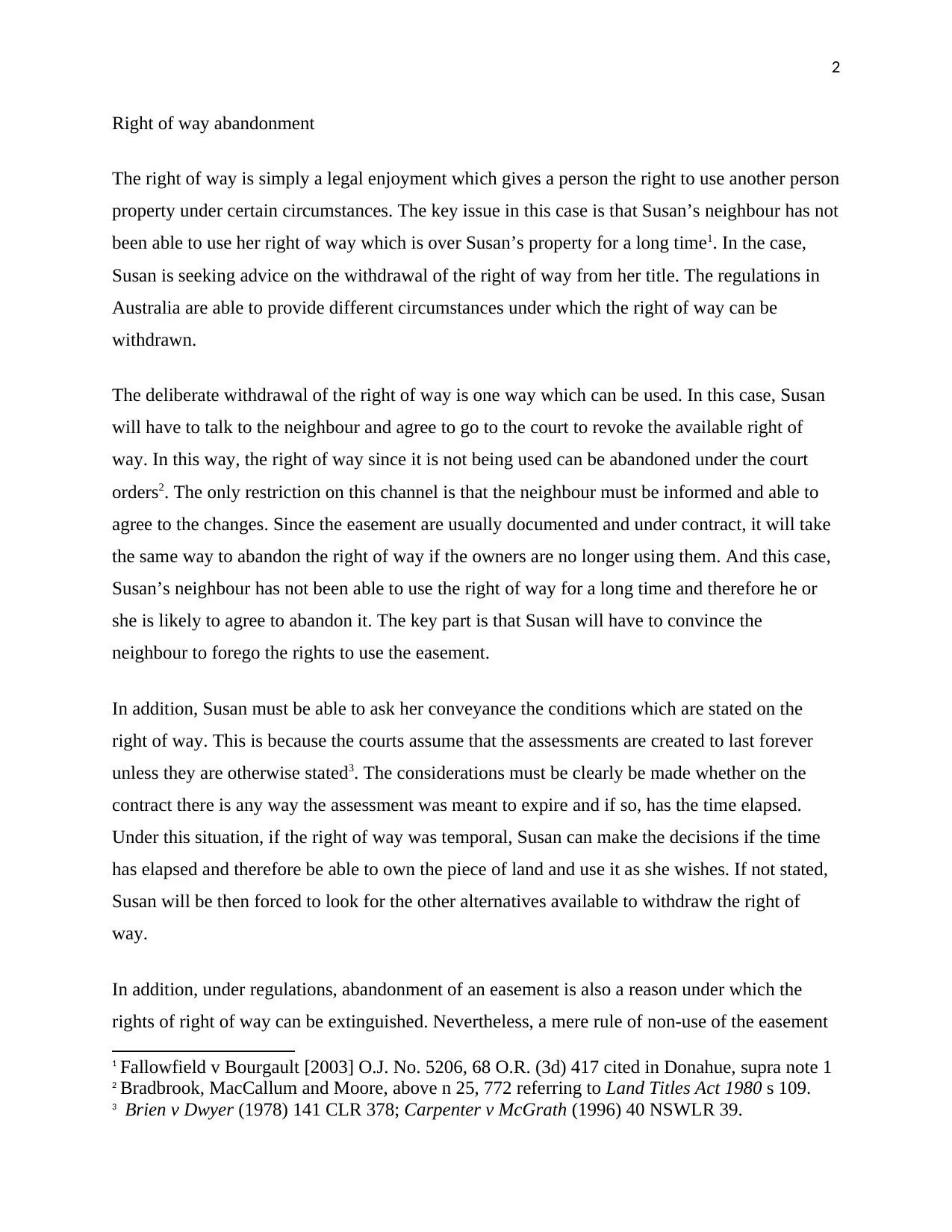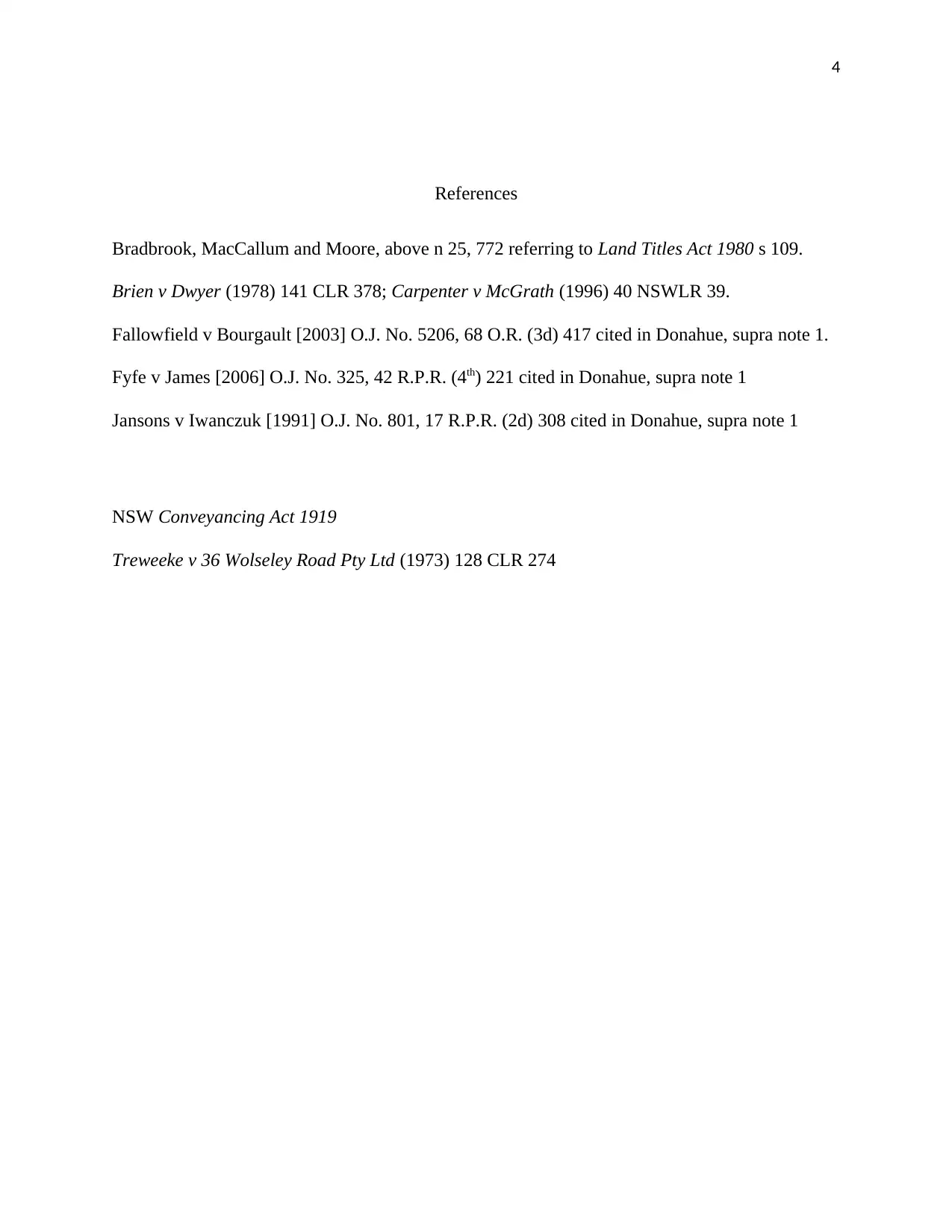Study on the Deliberate Withdrawal
VerifiedAdded on 2020/04/15
|4
|923
|48
AI Summary
Contribute Materials
Your contribution can guide someone’s learning journey. Share your
documents today.

1
Name:
Course:
Professor:
Date:
Name:
Course:
Professor:
Date:
Secure Best Marks with AI Grader
Need help grading? Try our AI Grader for instant feedback on your assignments.

2
Right of way abandonment
The right of way is simply a legal enjoyment which gives a person the right to use another person
property under certain circumstances. The key issue in this case is that Susan’s neighbour has not
been able to use her right of way which is over Susan’s property for a long time1. In the case,
Susan is seeking advice on the withdrawal of the right of way from her title. The regulations in
Australia are able to provide different circumstances under which the right of way can be
withdrawn.
The deliberate withdrawal of the right of way is one way which can be used. In this case, Susan
will have to talk to the neighbour and agree to go to the court to revoke the available right of
way. In this way, the right of way since it is not being used can be abandoned under the court
orders2. The only restriction on this channel is that the neighbour must be informed and able to
agree to the changes. Since the easement are usually documented and under contract, it will take
the same way to abandon the right of way if the owners are no longer using them. And this case,
Susan’s neighbour has not been able to use the right of way for a long time and therefore he or
she is likely to agree to abandon it. The key part is that Susan will have to convince the
neighbour to forego the rights to use the easement.
In addition, Susan must be able to ask her conveyance the conditions which are stated on the
right of way. This is because the courts assume that the assessments are created to last forever
unless they are otherwise stated3. The considerations must be clearly be made whether on the
contract there is any way the assessment was meant to expire and if so, has the time elapsed.
Under this situation, if the right of way was temporal, Susan can make the decisions if the time
has elapsed and therefore be able to own the piece of land and use it as she wishes. If not stated,
Susan will be then forced to look for the other alternatives available to withdraw the right of
way.
In addition, under regulations, abandonment of an easement is also a reason under which the
rights of right of way can be extinguished. Nevertheless, a mere rule of non-use of the easement
1 Fallowfield v Bourgault [2003] O.J. No. 5206, 68 O.R. (3d) 417 cited in Donahue, supra note 1
2 Bradbrook, MacCallum and Moore, above n 25, 772 referring to Land Titles Act 1980 s 109.
3 Brien v Dwyer (1978) 141 CLR 378; Carpenter v McGrath (1996) 40 NSWLR 39.
Right of way abandonment
The right of way is simply a legal enjoyment which gives a person the right to use another person
property under certain circumstances. The key issue in this case is that Susan’s neighbour has not
been able to use her right of way which is over Susan’s property for a long time1. In the case,
Susan is seeking advice on the withdrawal of the right of way from her title. The regulations in
Australia are able to provide different circumstances under which the right of way can be
withdrawn.
The deliberate withdrawal of the right of way is one way which can be used. In this case, Susan
will have to talk to the neighbour and agree to go to the court to revoke the available right of
way. In this way, the right of way since it is not being used can be abandoned under the court
orders2. The only restriction on this channel is that the neighbour must be informed and able to
agree to the changes. Since the easement are usually documented and under contract, it will take
the same way to abandon the right of way if the owners are no longer using them. And this case,
Susan’s neighbour has not been able to use the right of way for a long time and therefore he or
she is likely to agree to abandon it. The key part is that Susan will have to convince the
neighbour to forego the rights to use the easement.
In addition, Susan must be able to ask her conveyance the conditions which are stated on the
right of way. This is because the courts assume that the assessments are created to last forever
unless they are otherwise stated3. The considerations must be clearly be made whether on the
contract there is any way the assessment was meant to expire and if so, has the time elapsed.
Under this situation, if the right of way was temporal, Susan can make the decisions if the time
has elapsed and therefore be able to own the piece of land and use it as she wishes. If not stated,
Susan will be then forced to look for the other alternatives available to withdraw the right of
way.
In addition, under regulations, abandonment of an easement is also a reason under which the
rights of right of way can be extinguished. Nevertheless, a mere rule of non-use of the easement
1 Fallowfield v Bourgault [2003] O.J. No. 5206, 68 O.R. (3d) 417 cited in Donahue, supra note 1
2 Bradbrook, MacCallum and Moore, above n 25, 772 referring to Land Titles Act 1980 s 109.
3 Brien v Dwyer (1978) 141 CLR 378; Carpenter v McGrath (1996) 40 NSWLR 39.

3
was quoted not to be a clear reason for withdrawal of easement. According to case Treweke v 36
Wolseley Road Pty Ltd, there are some reasons which will make the right of way to be used4. For
instance, in this case, Susan’s neighbour is disabled and this may be a key reason why she has
not used the right of way. Therefore, since the neighbour to Susan is disabled and uses only
wheelchair, this does not mean that she does not use the assessment out of her own will. In
addition, the neighbour may have a strong case that the right of way is kept for the other
descendants who are not near. Therefore the mere fact that the neighbour does not use the right
of way does not mean she does not need it. This means that Susan cannot merely block the right
of way from the neighbour because of the long duration without using it. According to Jansonv
v. Iwancuz, it was declared that a mere non-use of the assessment does not guarantee that the
assessment is not needed56. Therefore it will be a tough case to argue on the prolonged non-use
of the assessment to remove it from the title.
Lastly, Susan can be able buy off her property and therefore be able to revoke the right of way
issues. The law states that if the owners of the right of way and at the same time own the piece of
land, he or she can be able to abandon the right of way. Since she will be able to how the both
pieces of dominant and servient property, the right of way will become obsolete and non-
functional7. In addition, Susan cannot talk only to the neighbour and enter into a verbal
agreement on the abandonment of the right of way.
4 Treweeke v 36 Wolseley Road Pty Ltd (1973) 128 CLR 274
5 Fyfe v James [2006] O.J. No. 325, 42 R.P.R. (4th) 221 cited in Donahue, supra note 1
6 Jansons v Iwanczuk [1991] O.J. No. 801, 17 R.P.R. (2d) 308 cited in Donahue, supra note 1
7 NSW Conveyancing Act 1919
was quoted not to be a clear reason for withdrawal of easement. According to case Treweke v 36
Wolseley Road Pty Ltd, there are some reasons which will make the right of way to be used4. For
instance, in this case, Susan’s neighbour is disabled and this may be a key reason why she has
not used the right of way. Therefore, since the neighbour to Susan is disabled and uses only
wheelchair, this does not mean that she does not use the assessment out of her own will. In
addition, the neighbour may have a strong case that the right of way is kept for the other
descendants who are not near. Therefore the mere fact that the neighbour does not use the right
of way does not mean she does not need it. This means that Susan cannot merely block the right
of way from the neighbour because of the long duration without using it. According to Jansonv
v. Iwancuz, it was declared that a mere non-use of the assessment does not guarantee that the
assessment is not needed56. Therefore it will be a tough case to argue on the prolonged non-use
of the assessment to remove it from the title.
Lastly, Susan can be able buy off her property and therefore be able to revoke the right of way
issues. The law states that if the owners of the right of way and at the same time own the piece of
land, he or she can be able to abandon the right of way. Since she will be able to how the both
pieces of dominant and servient property, the right of way will become obsolete and non-
functional7. In addition, Susan cannot talk only to the neighbour and enter into a verbal
agreement on the abandonment of the right of way.
4 Treweeke v 36 Wolseley Road Pty Ltd (1973) 128 CLR 274
5 Fyfe v James [2006] O.J. No. 325, 42 R.P.R. (4th) 221 cited in Donahue, supra note 1
6 Jansons v Iwanczuk [1991] O.J. No. 801, 17 R.P.R. (2d) 308 cited in Donahue, supra note 1
7 NSW Conveyancing Act 1919

4
References
Bradbrook, MacCallum and Moore, above n 25, 772 referring to Land Titles Act 1980 s 109.
Brien v Dwyer (1978) 141 CLR 378; Carpenter v McGrath (1996) 40 NSWLR 39.
Fallowfield v Bourgault [2003] O.J. No. 5206, 68 O.R. (3d) 417 cited in Donahue, supra note 1.
Fyfe v James [2006] O.J. No. 325, 42 R.P.R. (4th) 221 cited in Donahue, supra note 1
Jansons v Iwanczuk [1991] O.J. No. 801, 17 R.P.R. (2d) 308 cited in Donahue, supra note 1
NSW Conveyancing Act 1919
Treweeke v 36 Wolseley Road Pty Ltd (1973) 128 CLR 274
References
Bradbrook, MacCallum and Moore, above n 25, 772 referring to Land Titles Act 1980 s 109.
Brien v Dwyer (1978) 141 CLR 378; Carpenter v McGrath (1996) 40 NSWLR 39.
Fallowfield v Bourgault [2003] O.J. No. 5206, 68 O.R. (3d) 417 cited in Donahue, supra note 1.
Fyfe v James [2006] O.J. No. 325, 42 R.P.R. (4th) 221 cited in Donahue, supra note 1
Jansons v Iwanczuk [1991] O.J. No. 801, 17 R.P.R. (2d) 308 cited in Donahue, supra note 1
NSW Conveyancing Act 1919
Treweeke v 36 Wolseley Road Pty Ltd (1973) 128 CLR 274
1 out of 4
![[object Object]](/_next/static/media/star-bottom.7253800d.svg)





